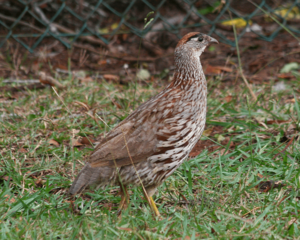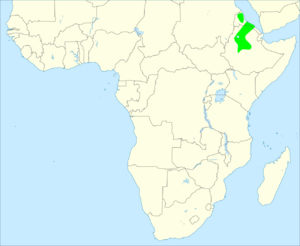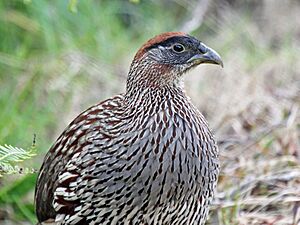Erckel's spurfowl facts for kids
Quick facts for kids Erckel's spurfowl |
|
|---|---|
 |
|
| Conservation status | |
| Scientific classification | |
| Genus: |
Pternistis
|
| Species: |
erckelii
|
 |
|
| geographic distribution | |
| Synonyms | |
|
|
The Erckel's spurfowl (scientific name: Pternistis erckelii) is a cool bird that's also called the Erckel's francolin. It's a type of game bird, which means people sometimes hunt it. This bird belongs to the Phasianidae family, which includes pheasants and partridges.
Contents
About Erckel's Spurfowl
How It Got Its Name
The Erckel's spurfowl was first described in 1835 by a German scientist named Eduard Rüppell. He found these birds in the mountains of Ethiopia. Rüppell gave the bird its scientific name, Perdix erckelii, to honor his helper, Theodor Erckel. Theodor helped him collect the bird specimens.
Today, scientists place this bird in a different group, or genus, called Pternistis. This group was named by another German scientist, Johann Georg Wagler, in 1832. The Erckel's spurfowl is a unique species, meaning there are no different types or subspecies of it. Scientists have also found that it is most closely related to the Djibouti spurfowl.
What It Looks Like
The Erckel's spurfowl is the biggest spurfowl in Africa! It grows to be about 38 to 43 centimeters (about 15 to 17 inches) long. Female birds are usually a little smaller than males. Males can weigh between 1.05 and 1.59 kilograms (about 2.3 to 3.5 pounds). One female bird was found to weigh about 1.136 kilograms (about 2.5 pounds).
Both male and female Erckel's spurfowls look very similar. Their bodies are covered with stripes of chestnut-brown feathers. They have a black face and a black beak. The top of their head and the back of their neck are chestnut-colored. Their legs are yellow. They also have white patches near their ears and a white stripe behind each eye.
Where It Lives
The Erckel's spurfowl naturally lives in the northern parts of Eritrea and Ethiopia. You can also find it in northeast Sudan. In 1957, some of these birds were brought to Hawaii to be game birds. They have also been introduced to Italy.
These birds like to live in high places, usually between 2,000 and 3,500 meters (about 6,500 to 11,500 feet) above sea level. This includes mountainous areas like the Degua Tembien district. Even though we don't know exactly how many Erckel's spurfowls there are, they are quite common. They live across a large area, about 580,000 square kilometers (about 224,000 square miles). Because of this, the International Union for Conservation of Nature says they are a species of "least concern". This means they are not currently in danger of disappearing.
How It Behaves
Erckel's spurfowls can hunt for food alone or in pairs. They often look for food in scrublands or at the edges of forests. They eat plants like berries, seeds, and young shoots. They also enjoy eating insects.
These birds are often quiet and still. But if they feel threatened, they will quickly run up a hill to escape. They make special calls to mark their territory. These calls have about 15 to 20 notes and are made from clifftops or large rocks. Their calls are often repeated for a long time. People have described their calls as "an insane cackled laughter" that speeds up towards the end.
Erckel's spurfowls lay their eggs during the rainy season, which is from April to November. The exact time depends on where they live. In Ethiopia, they lay eggs in May and from September to November. In Sudan, they lay eggs in April and May.



